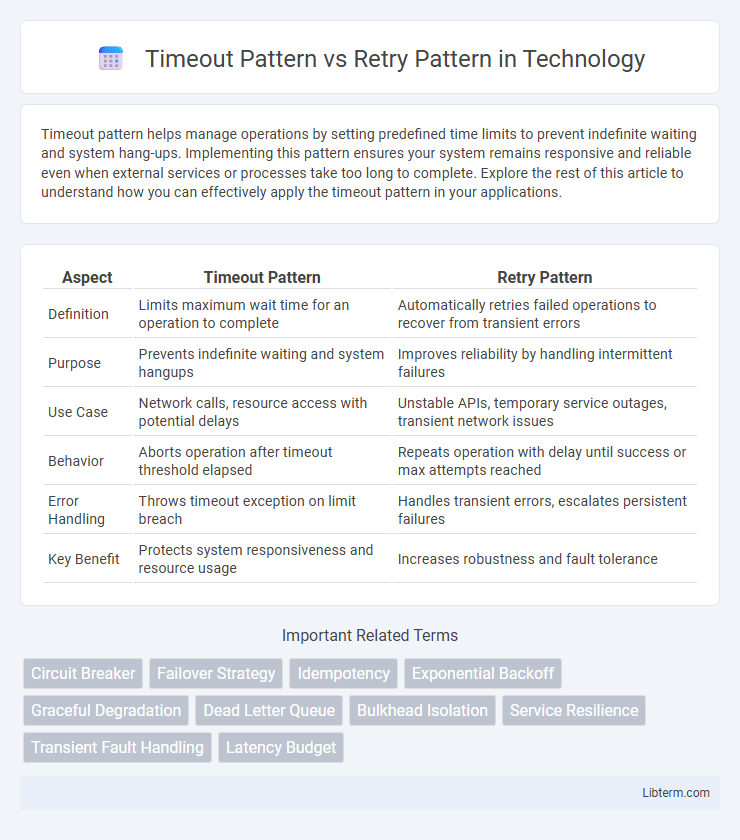Timeout pattern helps manage operations by setting predefined time limits to prevent indefinite waiting and system hang-ups. Implementing this pattern ensures your system remains responsive and reliable even when external services or processes take too long to complete. Explore the rest of this article to understand how you can effectively apply the timeout pattern in your applications.
Table of Comparison
| Aspect | Timeout Pattern | Retry Pattern |
|---|---|---|
| Definition | Limits maximum wait time for an operation to complete | Automatically retries failed operations to recover from transient errors |
| Purpose | Prevents indefinite waiting and system hangups | Improves reliability by handling intermittent failures |
| Use Case | Network calls, resource access with potential delays | Unstable APIs, temporary service outages, transient network issues |
| Behavior | Aborts operation after timeout threshold elapsed | Repeats operation with delay until success or max attempts reached |
| Error Handling | Throws timeout exception on limit breach | Handles transient errors, escalates persistent failures |
| Key Benefit | Protects system responsiveness and resource usage | Increases robustness and fault tolerance |
Introduction to Timeout and Retry Patterns
Timeout and Retry patterns are essential techniques in software engineering for handling operation failures and ensuring system resilience. The Timeout Pattern defines a maximum wait duration for an operation to complete before aborting it, preventing indefinite blocking or resource exhaustion. The Retry Pattern involves reattempting a failed operation a predetermined number of times with delays between attempts, aiming to recover from transient errors without overwhelming the system.
Key Differences Between Timeout and Retry Patterns
The Timeout Pattern defines a fixed time limit for an operation to complete, terminating the process if the limit is exceeded to prevent resource blocking and improve system responsiveness. In contrast, the Retry Pattern attempts to execute an operation multiple times after failures, aiming to recover from transient errors and increase overall reliability. Key differences include the Timeout Pattern emphasizing time constraints and failure handling through cancellation, while the Retry Pattern focuses on repeated attempts to achieve success despite temporary issues.
How the Timeout Pattern Works
The Timeout Pattern works by setting a maximum duration for an operation to complete before it is automatically terminated, preventing indefinite waiting and resource blocking. It monitors the elapsed time during a process execution and aborts the task once the predefined threshold is reached, ensuring system responsiveness. This pattern is crucial in distributed systems to avoid cascading failures caused by slow or unresponsive services.
How the Retry Pattern Functions
The Retry Pattern functions by automatically attempting to execute a failed operation multiple times before aborting, aiming to overcome transient errors such as temporary network issues or service unavailability. It typically involves configurable parameters like the maximum number of retries, delay intervals between attempts, and exponential backoff strategies to reduce system load and improve success rates. By handling retries programmatically, this pattern enhances application resilience and reliability without requiring manual intervention.
Ideal Scenarios for Using Timeout Pattern
The Timeout Pattern is ideal in scenarios where system responsiveness is critical and operations must be aborted if they exceed a predefined duration, preventing resource blocking and enhancing user experience. It is particularly effective in distributed systems with unpredictable latency, ensuring that requests failing to complete promptly do not degrade overall system performance. This pattern is also beneficial when dealing with external services that may become unresponsive, allowing the application to fail fast and trigger fallback mechanisms.
Best Use Cases for Retry Pattern
The Retry Pattern is best suited for transient faults such as network timeouts, temporary service unavailability, or intermittent errors where the operation is likely to succeed if attempted again after a short delay. It is ideal for scenarios involving unreliable external APIs, database connections, and cloud services prone to occasional failures. Implementing exponential backoff with jitter in retries enhances system resilience and prevents overwhelming the service.
Advantages and Limitations of Timeout Pattern
The Timeout Pattern improves system resilience by preventing indefinite waiting periods, thus reducing resource blocking and enhancing overall responsiveness. It allows applications to fail fast and recover more quickly, which is crucial in distributed systems where network delays or failures occur. However, the Timeout Pattern can lead to incomplete operations or data inconsistencies if timeouts are set too aggressively or without proper coordination in complex transactions.
Pros and Cons of Retry Pattern
The Retry Pattern improves system reliability by automatically resubmitting failed requests, reducing the chances of transient errors causing permanent failures. However, it can increase latency and resource consumption if retries are excessive or not properly throttled, potentially leading to cascading failures and system overload. Careful configuration of retry intervals and maximum attempts is essential to balance error recovery with system performance.
Combining Timeout and Retry Patterns
Combining the Timeout and Retry Patterns enhances system resilience by setting fixed limits on operation duration while controlling retry attempts to avoid cascading failures and resource exhaustion. Implementing a timeout ensures that each retry does not hang indefinitely, while configuring retry policies with exponential backoff or jitter prevents overwhelming services during transient faults. Effective use of these patterns requires tuning timeout durations and retry counts based on system latency characteristics and failure behavior to optimize reliability and responsiveness.
Choosing the Right Pattern for Your Application
Choosing between the Timeout Pattern and Retry Pattern depends on application requirements for responsiveness and reliability under failure conditions. Timeout Pattern is ideal for scenarios needing quick failure detection to prevent resource blockage, while Retry Pattern suits transient failure recovery with configurable backoff strategies to minimize load. Evaluate your system's tolerance for delays, failover strategy, and error frequency to select the pattern that optimally balances availability and performance.
Timeout Pattern Infographic

 libterm.com
libterm.com